|
|
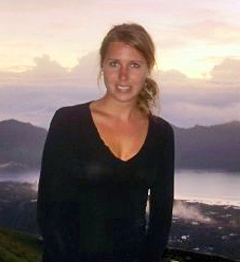
Emily
Hale
The Water School |
For
the full and far more interesting answer, we
turned to Water School representative Emily
Hale who was on the climb team and kept a
detailed journal of the assault on the summit and
the subsequent descent - both of which took a
heavy toll on the intrepid climbers. From this
point forward, I will let Emily's report tell the
story in her own words.
Emily
Hale: For the climbers, the six-day
trek was one of the greatest accomplishments
they have ever achieved. On Day One
(Monday, March 1) all climbers made their way via
van and bus ride up the steep road to the gates at
the foot of the mountain. We were graciously
welcomed to the mountain by our leader Godfrey
and assistant guide Robert. These two
individuals would lead the way through fog, rain,
hail and ice for the following six days! |
Accompanying
our group were 64 porters to carry tents, food and
luggage up the mountain for the climbers. We all
discovered very quickly that these porters had more
strength and perseverance than all of us combined! Just
five minutes into the walk the African skies opened and
the rain poured down. Seven hours later and about
18 kilometers down the path, we arrived at the Machame
camp site (2,890 meters high), wet and tired.
|
The
porters set up camp, with over a dozen sleeping tents, dinner tents and cooking tents. The problem was locating your designated duffel bag of clothes and supplies among the mounds of other bags. Sure enough, one duffel bag, which was shared by two of the
climbers, Tessa Holcomb and Kamila
Sekiewicz, (both from Sedo.com) had been misplaced and
left at the hotel! The two women were quickly outfitted in borrowed clothes and sleeping bags, and arrangements were made to receive their duffel bag the following day. The best part of day one came around
7pm when we were presented with a hot meal of delicious soup and vegetables. We all left
dinner exhausted and longing for |

On
Day One, Tessa Holcomb and Kamila
Sekiewicz
reached camp but their duffel bag didn't! |
| bed.
The drop in temperature was surprising, as it
dipped below freezing. This made sleeping
very difficult for those who were novices at
camping in the cold. |
Day
two began with a hot breakfast of cream of wheat, eggs, and sausages. The climbers prepared for the day’s hike, filling day packs with
water bottles, protein bars and rain gear.
As the climb resumed, people began to separate into
groups - the individuals who preferred a faster pace lead the way, while those pacing themselves formed their own groups behind. The rainforest disappeared and
shrubs and moss like bushes covered the ground. Half way through the day everyone met for a hot lunch, which had been set up in the middle of an open
area with two large tents. The climb continued after lunch, but the sunny skies were soon replaced by dark clouds and the
rain began to pour again. Fortunately, it was a shorter day, only 9 kilometers of hiking until
Shira camp at 3,840 meters high. After dinner, fatigue set in and everyone was off to bed after their pulse and oxygen levels had been checked.
Temperatures were again well below freezing. The
day three climb was extremely rocky and climbers learned the importance of carefully placing your steps to avoid slipping or rolling an ankle. 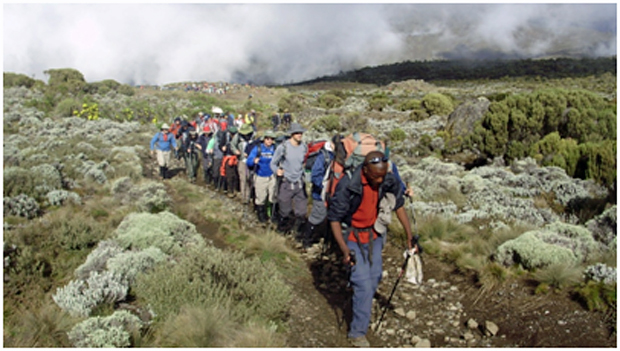
Climbers
navigate through a rock-strewn path on day three. The 15 kilometer
leg on day three was separated by lunch at the highest point, known as
Lava Tower, at over 4,600 meters high. We then
wound around to Barranco camp which we reached by
early evening. This camp was situated in a valley, and oddly enough, climbers were able to find reception for their cell phones if they were standing in just the right position, facing just the right direction, at just the right angle. By day three, some people were showing signs of
altitude mountain sickness (AMS), and suffered headaches and nausea. A hot supper was well received and worn out climbers quickly situated themselves inside their tents and slept in the frosty temperatures which surrounded them.
|
Day four would turn out to be a
very long and cold day for some. It would also be the
last day before the most important event of the climb –
the summit! The first part of the morning was the most challenging. Climbers would test their skills and agility climbing almost
straight up what is known as “the Barranco
wall”. Every step had to be carefully placed and weighted against the
rocks. Looking down would only make matters worse, since the valley was steep and the bottom appeared many meters away. The second half of the trek continued after lunch, but seemed
never ending. The trails were winding and steep as they wrapped around the mountain side, going up and down at steep inclines. The 15 kilometer
day four hike took everyone well into the late afternoon to complete. The worst weather conditions
also came on day four. As the temperatures dropped, the rain that everyone had been used to
transformed into ice pellets which violently cascaded down from the sky. Arriving to
Barafu camp by early evening, the tents were
covered in ice. By the time everyone arrived it was dark and
climbers were reminded that they should get as much rest as possible before attempting to summit in the early hours of
day five. |
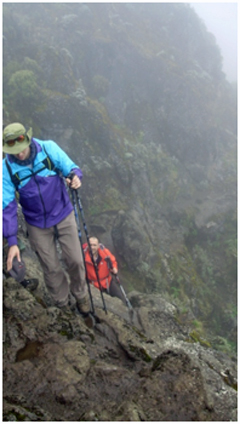
Matthias
Kaiser & Uzay Kadak
make their way up the Barranco Wall
on day four of the Kilimanjaro climb. |
Being woken in the
first hour of day five was shocking to most. The climbers arose from their tents distraught and exhausted from the long day of hiking on day four. Godfrey had informed everyone that the summit attempt would be
long and dark. The standard attempt would take about
eight hours to reach the summit, Uhuru Peak
(5,895 meters), and then the descent would take another few hours. There wasn’t much time for breakfast,
so instead climbers filled their day packs with protein bars, energy gels and water bottles. Equipped with only day packs and head lamps, at
2am climbers began making their way to the summit. Almost immediately the group was separated by pace and two smaller groups formed, each with a guide and a few porters which would stay nearby in case anyone needed assistance.
Nausea, vomiting, headaches and exhaustion were all common symptoms of high altitude. At this point one of the climbers faced
severe AMS and was forced to turn around and return to camp.
|
|
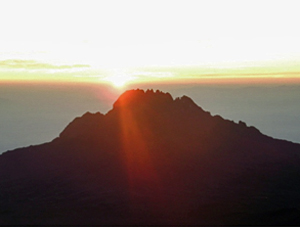
Sunrise
over Muru peak |
Slowly the groups made their way up the snowy peak. Zig zagging across the rocks to make it easier on the body, the scene could be compared to watching a movie in slow motion. The
lack of oxygen prevents any kind of speed or exertion in a person’s step. Taking breaks every hundred meters is essential in order to catch one’s breath and regroup from the nausea and headaches. The sunrise over
Muru peak in the distance was breath taking
and stopped everyone in their tracks for a few minutes. The sunrise meant warmer temperatures were on their way and the heat would help to thaw frozen fingers and toes. |
Conquering the summit took
pure willpower and determination for everyone. Sure enough, by the time the sun was beaming down on the mountain, the first group of climbers could see the top. However, the group quickly realized that although the top was in sight, the peak, called
“Stella’s Point,” would take another hour of climbing.
The snowy trek to the peak was even more draining due to the lower oxygen levels.
|
At last, the first team of three,
Todd Erhlich, Mick Honan and Emily Hale reached the peak in an astonishing time of five-and-a-half hours!
Victory!
This would be just the beginning as the other 23 climbers made the summit in the following hours of the day, and into the afternoon, scattered into groups of two or three. The only thing which kept most people going was the enthusiasm and encouragement from fellow climbers who had just visited the peak and were making their way back down the mountain.
The sign on the peak explained it all, congratulating us for reaching the
highest point in Africa at 5,895 meters high! Customary pictures
with this sign were taken as proof that a climber
had reached the summit. After |
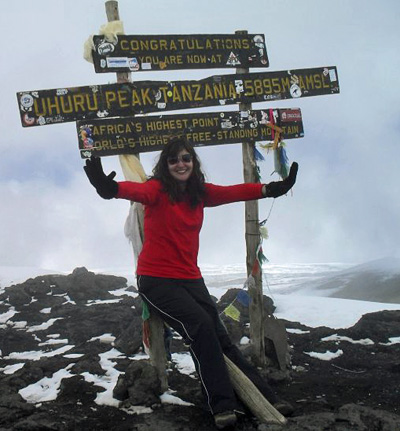
Jazmin
Carillo (Parked.com) - one of the 26
climbers
who reached the summit of Mount
Kilimanjaro. |
| photos
and many hugs with those who had joined the
journey to the top, climbers slowly made their way
back down. It wasn’t possible to spend much time
enjoying your triumph at the peak due to the thin
air which caused dizziness and
disorientation. |
|
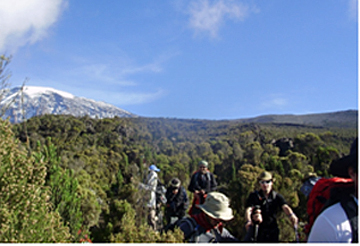
Climbers
making their way
back down from the summit. |
The
climb back down seemed almost as difficult
and much longer. The daylight hours made the
mountain appear like an endless path winding down,
and the camp would not be in sight until the last
few hundred meters. On the way down from the summit
we all realized why climbingin the dark was vital to successfully completing the climb: the darkness hid the daunting height of the mountain forcing climbers to focus only on the steps in front of them.
Those who had first descended from the summit had time to rest and pack their belongings to move camp down the mountain to a site called
“Millennium”. The groups were still |
| scattered,
and it wasn’t until part way through dinner that
everyone arrived. The final night on the mountain
was quiet and everyone was anxious to begin the
final descent the next day and reward themselves
with showers and restaurant food! |
|
For almost everyone,
day six (Saturday, March 6) had started out like any other; packing and breakfast followed by getting ready for the day’s trek. Unfortunately for one individual,
Gregg |
| McNair, his feet had been so badly damaged
by the previous day's descent from the mountain that he called for help. The option of getting a helicopter was quickly diminished as the price increased more than ten-fold in a matter of hours! The only other option was a
wheel barrow like stretcher that he would be affixed to by ropes.
With Gregg tied to the stretcher, porters quickly pushed
it down the mountain, jolting and dislodging Gregg
to the point |

This
"stretcher" carried an injured Gregg
McNair
the balance of the way back down the mountain. |
| that
the stretcher almost flipped over several times.
Near the base of the mountain a jeep was able to
pick Gregg up, along with a couple others, and drop
them off at their final destination, Mweka
gate. By this time, most climbers were waiting and
the porters and guides said their final farewell
with a feast they presented to us. |
|
|

A
feast and farewell speeches
awaited the climbers after their
successful conquest of Kilimanjaro |
Speeches were made on behalf of
The Water School, congratulating everyone for their success and sponsorships of almost
$200,000 donated towards the Climb for Clean
Water.
By early afternoon, everyone headed back to a local hotel in
Moshi. Showers began running, drinks began pouring and
a long night of celebrating had just begun! Although the climb had physically ended, the event marked the start of many great things to come for
The Water School, and most importantly, thanks to
your contribution to the climb, over 20,000
people will have clean water for life!
One of the best
parts is knowing that 100% of your donation
is actually being donated, this is thanks to a
generous donor who has covered all administration
costs for 2010! That means each and every cent
is going directly towards implementing the Water
School Program, which is proven to protect children
and families from death due to consumption of
contaminated water.
Thanks again for making the climb a
great success! |
|
| And we
thank Emily for that fabulous first person account
of the group's adventure. And by the way, who said
it is "A Man's World"? The ladies
of Kili 2010 take a back seat to no one!
Though the climb is
over it is not too late to make
a donation to The Water School. The only
reason all of those climbers put their bodies on
the line is because they knew how much good every
single dollar contributed to the cause would do.
We congratulate each one of them for their great
accomplishment and effort to help less fortunate
people in developing nations overcome disease
and death that have been spread by waterborne
illnesses that the The Water School is working to
eradicate. |
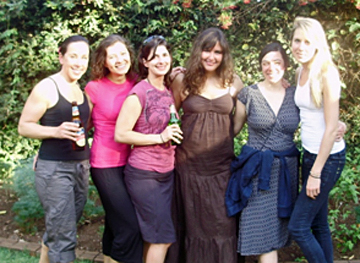
The
Ladies of Kili 2010 |
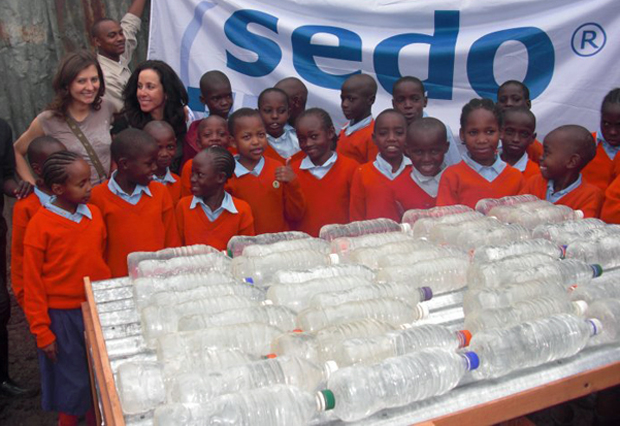
Sedo's
Kamila Sekiewicz and Tessa Holcomb with
some
of the young students at The Water School in Tanzania.
|

